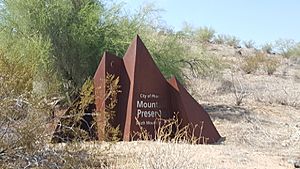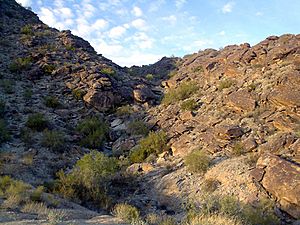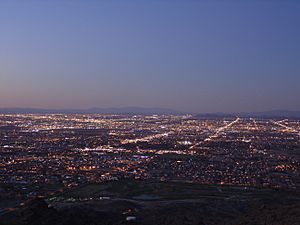South Mountain Park facts for kids
South Mountain Park in Phoenix, Arizona is a huge and amazing place! It's the biggest city park in the United States. It's also one of the largest urban parks in all of North America and even the world. People in Phoenix are very proud of it, and it's known as a Phoenix Point of Pride.
Contents
Exploring South Mountain Park
South Mountain Park protects a large, natural mountain area. It covers about 16,283 acres (which is about 66 square kilometers) of desert plants and animals. The park was created in 1924. Back then, President Calvin Coolidge sold the first 13,000 acres to the city of Phoenix for only $17,000!
How the Park Grew
Since its beginning, the park has gotten even bigger. More land was added in the 1970s and early 1980s. It's called South Mountain Park because it's located south of downtown Phoenix. Over time, new neighborhoods have grown up around the park. For example, Ahwatukee is now to the south, and Laveen is to the west.
Park History and Names
South Mountain was first known as the Salt River Mountains. A special committee helped create the park. This committee included J.C. Dobbins, Mrs. John Hampton, and H.B. Wilkinson. You can still find Dobbins Road today, named after J.C. Dobbins. It runs just north of the park.
Fun Things to Do at the Park
The park has a lookout point that is over 1,000 feet (305 meters) higher than the desert floor. This spot gives you amazing views of Phoenix! Besides roads that lead to picnic areas and the summit, the park has 58 miles (93 kilometers) of trails. These trails are perfect for biking, hiking, and horseback riding.
A lot of the park's first buildings and paths were built in the early 1930s. This work was done by the Civilian Conservation Corps. This was a group of young men who worked on public projects during a tough time in history. The famous Mystery Castle is also located near the park's foothills.
Amazing Plants and Animals
South Mountain Park is home to many different kinds of plants and animals. It's a great place to see desert life up close!
Unique Plants: The Elephant Tree
One special plant you might see is the Elephant tree (Bursera microphylla). This tree is easy to spot because its trunk is twisted and has many branches. It looks a bit like an elephant's trunk or legs!
Cool Animals: The Chuckwalla Lizard
South Mountain Park is also famous for its chuckwalla lizards. In fact, it has more chuckwallas per area than any other place ever recorded! On average, there are about 65 chuckwallas in every hectare of the park.
What's really interesting is that the male chuckwallas at South Mountain have a special look. They have a "carrot tail," which means their tail is thick and orange, like a carrot! This unique feature is only found in the chuckwallas living in this park.





